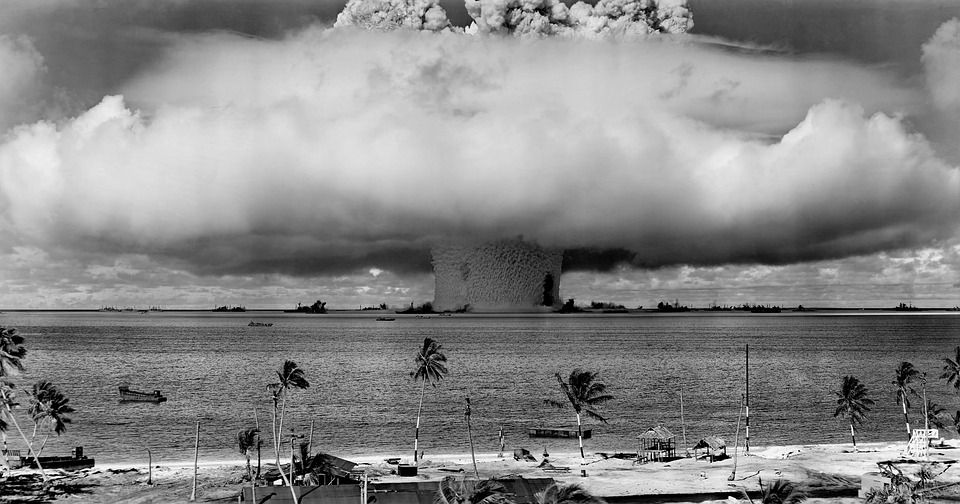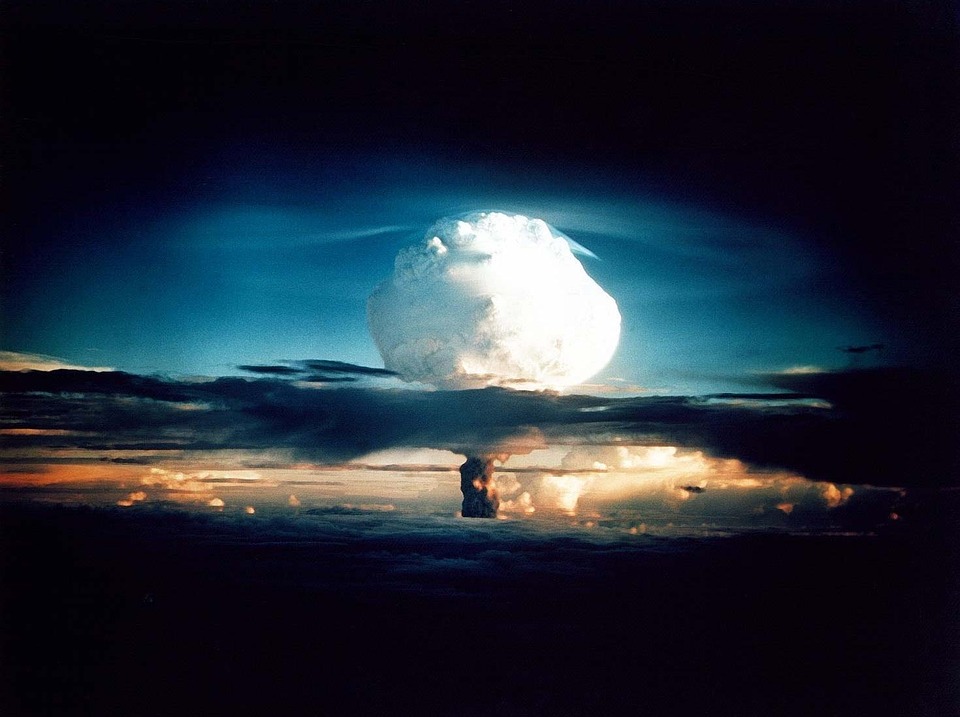Nuclear Power| Nuclear
Power is the most dangerous weapon that a country have. With the help of
Nuclear Power we also generate energy for our own benefit. Nuclear power has
it's own role when it comes to international geopolitics. So in this topic we
are going to discus the origins of the Nuclear power how it all started? And
also about it's race to discover it first. So let's Start :

Origin/ History Of Nuclear Power :
We begin in 1896. In
Paris, physicist Henri Becquerel accidentally discovers during an experiment
that uranium leaves a trace -- or darkens -- a photographic plate without any
other light source. He presumes that uranium normally transmits a beam he calls
"uranique" in French. In the following years, physicists Pierre and
Marie Curie discover other elements that also naturally emit radiation. They
call the phenomenon radioactivity. Later, Ernest Rutherford, a British
physicist born in New Zealand, suggests that radioactivity is radiation that
accompanies the disintegration of atoms, which were previously considered to be
indestructible. Other findings are then used to better understand the structure
of the atom, with electrons revolving around a nucleus composed of protons and
neutrons. In 1938, two German chemists, Hahn and Strassmann discover nuclear
fission. Bombarding an atom of uranium with a neutron, it is divided into two,
releasing energy. The following year in Paris, Frédéric Joliot-Curie discovers
that during the nuclear fission of uranium, three neutrons are ejected which in
turn could cause further fission of atoms. He discovers the ability to initiate
a chain reaction and thus produce a large amount of energy.

The Manhattan Project :
In 1939, in Europe, WorldWar II breaks out. While Germany keeps on directing exploration on uranium,
Albert Einstein is persuaded by Hungarian physicists to sign a letter routed to
Roosevelt, the President of the United States educating him regarding late
atomic revelations and the chance of making a ground-breaking bomb utilizing
uranium. The United States benefits from the influx of European scientists
fleeing war and invests in research. At the University of California, Glenn
Seaborg discovers that irradiated uranium produces a tiny amount of plutonium,
a new metal that is radioactive and fissile, i.e. it can trigger a chain
reaction. In Chicago, Enrico Fermi makes the primary nuclear heap and - just
because - figures out how to control the principal chain response of the
splitting of uranium molecules. Research is accelerated and substantial
resources are invested. The United States secretly launches the Manhattan
Project in collaboration with Canada and the United Kingdom. Top scientists
gather in about 30 secret locations, with the best laboratories at the time made
available to them. Their goal is to create the atomic bomb. In 1943, the goal
is to create a bomb from uranium and another from plutonium. In nature, uranium
is composed of more than 99% of Uranium 238, i.e. with a nucleus of 92 protons
and 146 neutrons, and 0.7% of Uranium 235, with three neutrons less. Only the
latter is fissile and therefore useful in the project. The challenge is
isolating and concentrating it to obtain so-called enriched uranium. The United
States figures out how to deliver 64 tons of profoundly improved uranium to be
utilized in the production of the primary bomb. By pushing an exceptionally
enhanced uranium square onto another, the material gets supercritical. Fission
begins and in a split second, a chain reaction ensues, releasing tremendous
amounts of energy. For a plutonium bomb, a maximum of uranium piles are created
in order to collect the plutonium produced. A few pounds are concentrated in
the center of the bomb. By simultaneously causing explosions all around, the
material is compressed, becomes supercritical and explodes. On 16 July 1945,
the primary fruitful atomic test happens in the desert of New Mexico. By this
point, Germany had just given up. Only the Empire of Japan is still at war
against the United States. After Japan refuses to surrender unconditionally,
the United States drops two atomic bombs on the country a uranium bomb on
Hiroshima and a plutonium one on Nagasaki. The two bombs cause about 200,000
civilian casualties. Days later, Japan surrenders. With the United States
exhibiting its capacity to the world, the USSR quickens its own atomic program
to attempt to make up for lost time.

The Cold War :
In 1949, the USSR conducts
its first nuclear test. During the Cold War, both powers engage in a frantic
arms race. Large sums are spent to gain technological superiority and possess
the world’s largest nuclear arsenal with the ostensible aim of deterring the
enemy from attacking. While the United Kingdom tests its first atomic bomb, the
United States tests its first thermonuclear bomb, also known as the hydrogen or
H-bomb. This is a fusion bomb, i.e. it reproduces the reaction occurring in
stars by fusing two light atoms, deuterium and tritium, under high pressure and
a temperature of several million degrees Celsius. To achieve these conditions,
it is decided to use the atomic bomb as a trigger. The explosion of the
plutonium bomb creates the right conditions to trigger the fusion of atoms. The
explosion that follows is far more powerful than nuclear fission. The Soviets,
in turn, develop the H-bomb.

The Nuclear Power :
In 1955, in parallel,
research is made to develop nuclear power. The first nuclear power plants
appear. The majority of future reactors would be with pressurized water. In the
core of the reactor is a vessel in which low-enriched uranium is placed and
used as fuel. Chain reactions are controlled to last about 3 years. The heat
emitted increases the temperature of pressurized water in the primary circuit.
This circuit is brought into contact with the secondary circuit in which water
heats to transform into steam. This is used to rotate the turbine which is
linked to a generator that produces electricity. A cooling circuit pumps water
from a river or sea to cool the vapor in the secondary circuit. Sometimes
cooling towers are built to cool the water in the last circuit. To encourage
research in nuclear power, the International Atomic Energy Agency (IAEA) is
created in 1959 under the aegis of the United Nations. The organization is
responsible for ensuring the safe and peaceful use of nuclear energy. In
addition, nuclear would also be used in medicine, notably in medical imaging
and the treatment of certain cancers.
In 1960, while France
tests its first atomic bomb, the arms race between the USSR and the United
States takes a turn for the worse. The two forces have just evolved
intercontinental rockets and atomic submarines. The USSR directs the most
impressive trial of the Tsar Bomba, with a limit of 50 to 57 megatons of TNT. The
following year, the US tests a hydrogen bomb at an altitude of 400 km. The
explosion creates an artificial aurora visible even from New Zealand; while the
emitted radiation damages at least 8 satellites. The same year, in 1962 while
the United States threatens Soviet territories with nuclear missiles installed
in Turkey and Italy, the USSR places in Cuba nuclear missiles pointed at the United
States. Just as tensions build to a climax, negotiations take place between the
two powers after which both parties withdraw their missiles and the situation
calms down.

Hydrogen Bomb
China tests its first
atomic bomb in 1964. The United States and Soviet Union takes a dim view of the
arrival of new competitors. Via the UN, they propose a Treaty on the
Non-Proliferation of Nuclear Weapons in 1968. This differentiates the 5
so-called nuclear powers from the rest of the world. Existing atomic forces
can't share information or flexibly weapons, while remaining nations can't
endeavor to get the nuclear bomb. In addition, nuclear powers are supposed to
disarm as much as possible. This treaty would gradually be signed by all
countries of the world with the exception of India, Pakistan and Israel, which
denies having atomic weapons despite heavy suspicion of the contrary. Latin
America goes further by creating the first populated area free of nuclear
weapons. At long last, the United States and Soviet Union consent to restrain
the creation of vital weapons. 1973 sees the world's first oil emergency. In a
short time, the price of a barrel of oil explodes, undermining global powers
whose economy largely depends on the black gold. The world looks for
alternatives to ensure their energy supply. France and Japan mainly rely on
nuclear energy. In the following years, many power plants would be built around
the world. In India, a supposed "tranquil" atomic test happens,
stressing its Pakistani opponent which thus sets out on atomic exploration. In
1979, a significant atomic mishap happens in the United States. One of the
reactors at the Three Mile Island atomic force plant floods and the essential
circuit spills. As the fuel is no longer submerged, it overheats and then melts
in its vessel. Fortunately, the containment resists and prevents radioactive
leaks. A few years later at the Chernobyl nuclear power plant, after a series
of human errors, technicians lose control of the reactor. At the point when the
temperature of its center turns out to be excessively high, a blast explodes
the solid rooftop, some portion of which falls and breaks the vessel. An
exceptionally radioactive cloud is delivered into the air. It spreads and
contaminates a large part of the European continent. Around the power plant, a
2,600 sq km exclusion zone is created and more than 200,000 people are
displaced. Around the globe, the mishaps produce or reinforce well known
restriction to atomic force, which puts a substantial brake on the advancement
of the business.

Proliferation :
In 1991, after the fall of
the USSR and the end of the Cold War, the US and Russia continue to reduce
their nuclear arsenals. In addition, after more than 2,000 official nuclear
tests in the world, the Comprehensive Nuclear-Test-Ban Treaty (CTBT) is
introduced in 1996. It doesn't go into power on the grounds that out of the 44
nations with atomic reactors at that point, three don't sign it and five others
sign however don't approve it. After two years, India and Pakistan direct a
progression of atomic tests. Abdul Qadeer Khan, thought about the dad of the
Pakistani nuclear bomb, recognizes having built up a covert system originatingin
Dubai, which has been giving Libya, Iran and North Korea with the plans and
materials necessary to create an atomic bomb. North Korea in 2006, after
withdrawing from the Treaty on the non-proliferation of nuclear weapons, now
declares that it has carried out its first nuclear test. At the same time, Iran
announces that it has successfully enriched uranium, which worries the
international community. Israel for its part maintains ambiguity over its
nuclear program. Many believe the country has dozens of atomic weapons, but the
latter neither confirms nor denies reports to deter any potential enemy.

Nuclear Waste :
One of the advantages of
nuclear power is that it emits little CO2. However, it generates radioactive
waste with a lifespan of up to several hundred thousand years. While most of
the waste has a lifespan of a few decades, current technologies do not offer a
definitive solution for high-level, long-lived waste. Most countries rely on
deep geological repositories to store nuclear waste more than 300 meters under
the Earth’s surface. On 11 March, 2011, Japan suffers a triple disaster. After
an 9.1-magnitude earthquake -- the most violent ever recorded in the country --
its coasts are hit by a powerful tsunami with a height of over 10 meters,
affecting the Fukushima nuclear plant. Accidents forestall the cooling of the
center of its reactors. Inside days, 4 reactors detonate, delivering a
profoundly radioactive cloud that is blown towards the Pacific Ocean, arriving
at the North American mainland and afterward spreading all through the northern
side of the equator. All 39 Japanese nuclear reactors are then shut down. In
the outcome, Germany reports an eliminating of atomic force. Somewhere else,
most atomic nations audit the wellbeing of their plants.

Current Situation of Nuclear Power :
While 9 countries still
have 16,000 nuclear bombs, at the UN, a Treaty on the Prohibition of Nuclear
Weapons, which aims at the complete elimination of nuclear weapons, is voted by
122 countries. Only the Netherlands votes against, while Singapore abstains.
But the vote is marked above all by the absence of many countries, including
the nuclear powers and member countries of NATO. If the treaty is ratified by
50 countries, it will come into force. Today, 34 countries have already
ratified it. As far as atomic force, 417 working reactors produce simply over
10% of the world's power. 46 reactors are under development, remembering 10 for
China whose vitality needs are expanding. Somewhere else on the planet, the
atomic armada is maturing. 66% of worldwide reactors are more established than
30 years, out of their initially arranged life expectancy of 40 years. Their
future destroying vows to be expensive. New ages of atomic force plants battle
to meet the world's rising vitality needs, while its development endures
critical deferrals and extra expenses. Meanwhile, 35 countries are
collaborating around the International Thermonuclear Experimental Reactor,
which is being carried out in France. The aim is to study the possibility of
building nuclear fusion power plants over the long term. Its budget has already
jumped from 5 to 19 billion euros, but if the project is successful it could
offer a new type of power plant that would produce a lot of power with minimal
crude material and next to no radioactive waste.

Pripyat Chernobyl
So that all about the
topic “Nuclear Power. History & how the nuclear Power Invented?” Thank You
for giving time to read it. I hope you learn something new and if you like it
then don’t forget to share it and to give credit click on any add.






0 Comments
Please Do not enter any spam link in the comment box.